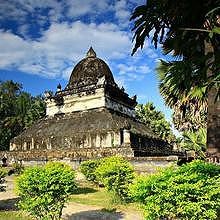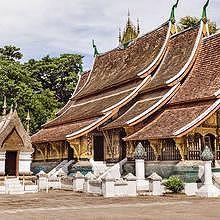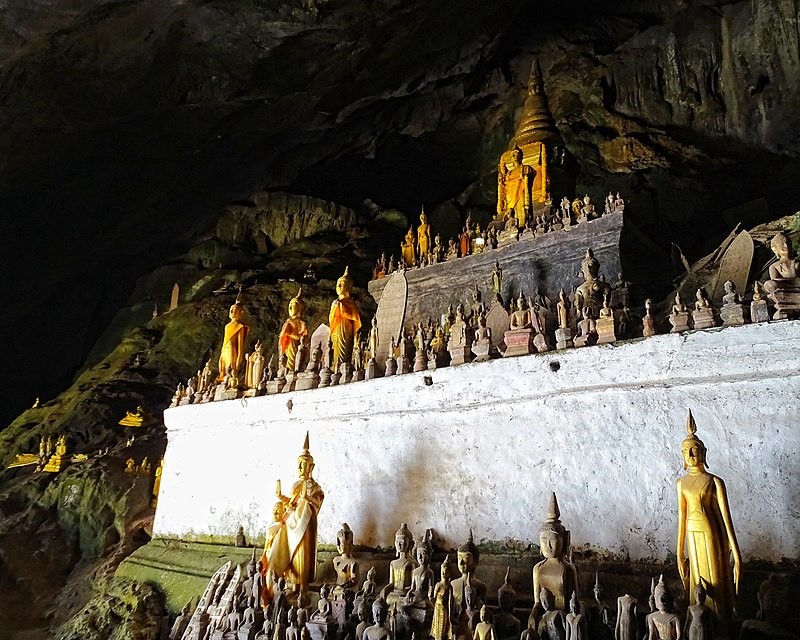ITINERARY
Luang Prabang and Its Surrounding Attractions – 5 Days / 4 Nights
Luang Prabang Int’l Airport to your hotel in Luang Prabang (4kms): 10 mins • Half day visit of Luang Prabang.
Arrive in the morning – visa processing, then meet with guide for transfer to hotel to drop your luggage & refresh after the flight.
Transfer to a local restaurant for lunch to enjoy a fresh and tasteful menu of Lao dishes, then proceed to a half day visit of Luang Prabang.
Luang Prabang was recognized by UNESCO as a world cultural heritage mostly because of the unique historical value of this royal city, where it witnessed the rule of 63 kings. Besides, the city is also a magnificent and mysterious Buddhist centre with thousands of temples, many of which are beautiful architectural accents, gilded with golden paint.
Not only that, Luang Prabang is also a peaceful, charming small city nestled on the green, poetic Mekong River and Nam Khan, surrounded by rolling mountains of clouds all year round.
In the past, this city was chosen to be the capital of the Lan Xang empire - the first kingdom of Laos (1350-1545). In the 16th century, although the capital was moved to Vientiane, Luang Prabang preserved its position as the cradle of Laos' diverse culture.
Luang Prabang is also a place to preserve the heritage of art and architecture: over 30 magnificent palaces, most built from the 14th century; about 40 ancient temples were built from different dynasties, each of which is a cultural work of high artistic value. Hundreds of antique wooden houses are designed in a very beautiful style, arranged in an orderly manner along the long and small streets, creating a lovely and still image.
The 1st visit is the former Royal Palace, now the National Museum where you will explore the history of Laos.
The Royal Palace Museum in Luang Prabang (also known as “Haw Kham” or "Golden Hall") was once Laos’ Royal Palace. It houses a lot of interesting historical items. Every item tells a story...so you will learn quite a lot about Lao history and about Laos’ royal.
Built in 1904, it features a blend of Lao traditional and French style. It was built for King Sisavang Vong and his family during the French colonial era.
After the death of King Sisavang Vong, the crown Prince Savang Vatthana and his family were the last to occupy the palace. After the revolution in 1975, the building was taken over by the government. The palace was then converted into a national museum and opened to the public in 1995.
Located in the city just the other side of the road from Phousi mountain, the palace is in walking distance of all main hotels and guest houses.
In the palace compound, there are several buildings to visit.
Continue with:
- Wat Visoun, the holiest temple of the city, which was entirely rebuilt in 1887 after being destroyed by the invading Black Flags from Southern China.
Founded in 1512 during the of King Visounnarath (1501-1520), this temple was a symbol of the Kingdom’s unity. The carved wooden railings in the temple’s windows are reminiscent of the Wat Phou temple in Champasak, in the far South of Laos. Inside you can admire ancient statues and steles. Also located on the grounds of this temple is the That Pathoume, also known as That Mak Mo (the watermelon stupa) because of its shape.
- Wat Xiengthong - an ancient royal temple built in 1560 and Wat May with 5-layer thick roofed tiles. They are two of the many beautiful tombs with excellent architectural features and decorative details. Wat Xiengthong has rich wood carvings and decorations.

- Wat Vixum, built in 1513 and then rebuilt in 1898. It worships the largest Buddha statue in Luang Prabang. In the same architectural complex, Ta Mak Mo is famous for its excellent hemispherical architecture.
From here, visitors can climb 328 steps of Phousi as it is the perfect spot for a sunset and vantage point of Luang Prabang Town, Phan Phao temple, Mekong River and Nam Son River from here. One of the city's roofs that visitors can see from above Phousi is the royal tombs of the past - the impressive double cross in the combination of sophisticated architectural details of Laos and France. Now these tombs have become museums with many precious artifacts.
After dinner, you can visit the hill tribe evening market for some shopping. This colorful market takes place every evening from around 5pm along the main streets of town and is a great place to look for souvenirs.
Overnight in Luang Prabang.
Road transfer to Pak Ou Caves, boating on Mekong & Nam Ou rivers, handicrafts villages visits.
Breakfast at your hotel.
Transfer to the pier & embark for a boat trip for approximately 2 hours and 40 minutes to visit: Pak Ou Caves, Ban Khok Village & Ban Hatkam Village (surnamed Whisky Village)
The Pak Ou Caves are filled with thousands of Buddha statues, set in a rocky cliff face overlooking the Mekong River. They’re located around 25 kilometers from Luang Prabang in Northern Laos. There are two caves: a lower cave not too far from the river level, and an upper cave that’s a steep 5-10-minute climb up stone steps.

On the way, stop to visit the holly Pak Ou caves. The caves themselves are very close to the confluence of the Nam Ou and Mekong Rivers, hence the name Pak Ou. In these 2 caves are displayed hundreds of sacred centuries-old Buddha images which are the object of pilgrimages during the Lao New Year festivities around mid-April.
Then get across the Mekong River to visit Ban Khok Village, where the access to the village is only by boat.
Continue the boat trip on Nam Ou River to visit Ban Sang Hay Village, a non-touristic village, where people live with simple way of life. Here you will see how local people produce traditionally liquor from sticky rice or Lao whiskey.
Boat back to the pier, then route transfer to hotel.
On the way back, stop at the weaving village of Ban Xang Khong specialised for many years in manufacturing and selling products made from silk and Saa Paper (paper made from the bark of the Saa Tree).

Overnight in Luang Prabang.
Morning offerings and in the rice field, afternoon at the falls of Kuang Si
At sunrise, your guide will join you at your hotel to accompany you and to explain the daily singular ritual of the Morning Alms (Sai Bat) to the monks.
Sai Bat (Morning Alms) is a longstanding tradition in Laos Buddhist culture. In observing it, the devoted offer food to monks throughout the Luang Prabang every morning. This is sustenance for the monks, so great care is taken in preparation (and visitors wishing to take part should follow guidelines to ensure that they make appropriate offerings).

Each morning, starting at around 05:30, saffron-robed monks and novices emerge onto the streets with their alms bowls (‘bat’). Awaiting them are Lao people who have already taken the time to prepare sticky rice and other foods; they will place a portion in the bowl of each monk who passes by. The ceremony is undertaken in complete silence.
The cultural significance and austere beauty of Sai Bat has made it a very popular tourist attraction in Luang Prabang. Most visitors witness the ceremony in the old city centre, along Sakkaline Road in particular.
Then you will pace the morning market where all the ethnic groups around are gathering back the products of hunting, fishing and gathering.
Return to your hotel for breakfast, then transfer to the rice field.
Continue the day meeting the producers of rice and organic vegetables.
During 3 hours, you will follow an introduction to all the stages of growing and preparation of rice. You will enjoy experimenting yourself, including feet in the mud to dry the buffalo when ploughing, planting and transplanting of shoots, turn the grain in flour. You will finish this morning by tasting some rice products whose variations are so numerous.

Then we will take the road for 1/2 hour, to join the falls of Kuang Si
Lunch in a restaurant, surrounded by small waterfalls.
Afternoon relaxation at Kuang Si Falls. Visit the Park of rescue Bear, and get a swim in one of the many natural pools with fresh and turquoise water.

Return before sunset, and transfer to hotel.
Overnight in Luang Prabang.
Morning trek in a hill tribe village, afternoon free at leisure, evening at the Caterer’s market
Breakfast at your hotel.
Pick up at hotel and drive out of town about 25 minutes.
After crossing the Khan River on a fishing boat, your trekking starts with visiting Hill Tribe villages through on the rice paddies and local plantations along the way.
After 2-3 hours of walk, you will arrive at a remote local village; you will then be able to see and to note what is the local daily lives for the majority of Lao people, specially minority groups. Learning (tradition, culture, architecture, religion, social structure) and interacting (with locals) are the main goal of the visit.
Lunch at the village.
Afternoon back to Luang Prabang. Free at leisure.
6PM: Your guide will lead you to the Caterer’s Evening Market to have dinner. You will have opportunity to see the local dishes not in restaurants.

This market opens from 5pm and often finishes before 9.30pm
This is a site which must not be missed if you want to taste Laotian specialities, which you very often can’t find even in restaurants. The Lao’s come here regularly to buy their food along with tourists who will find it typical, animated and very pleasant.
Numerous stalls, very often held by women, propose a large choice of prepared dishes, hot and cold, so that curious visitors can try out the local food, which he is not likely to find, even in typical restaurants. There are many interesting and exotic specialities in Luang Prabang.
Back to hotel.
Overnight in Luang Prabang.
